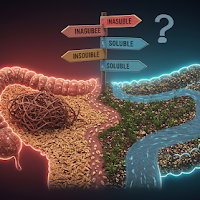You're eating "healthy," but you feel bloated and uncomfortable. The problem might not be too much fiber—it might be the wrong kind.
We've had it drilled into our heads for decades: "Eat more fiber." It's the cornerstone of any healthy diet, credited with everything from weight loss and heart health to cancer prevention. So you diligently add beans to your salad, snack on apples, and switch to whole-grain bread. But instead of feeling vibrant and healthy, you just feel... gassy and bloated.
This is the fiber paradox. The truth is, not all fiber is created equal. The "eat more" advice is dangerously oversimplified, because there are two very different types of fiber that perform completely different jobs in your body. Understanding the difference is the key to unlocking the real benefits—and avoiding the discomfort.
The Two Faces of Fiber: Soluble vs. Insoluble
Soluble Fiber
How It Works
This type of fiber dissolves in water to form a thick, gel-like substance in your digestive tract.
Key Benefits
- Slows digestion, making you feel fuller for longer.
- Helps stabilize blood sugar levels.
- Binds with cholesterol and removes it from the body.
Top Food Sources
- Oats and Barley
- Beans, Peas, and Lentils
- Apples, Citrus Fruits, and Carrots
- Psyllium Husk
Insoluble Fiber
How It Works
This type does not dissolve in water. It adds bulk to the stool and acts like a "broom," sweeping material through your gut.
Key Benefits
- Promotes regularity and prevents constipation.
- Increases stool bulk and speeds up transit time.
- Supports a healthy gut microbiome.
Top Food Sources
- Whole-Wheat Flour and Wheat Bran
- Nuts and Seeds
- Cauliflower, Green Beans, and Potatoes
- Beans (they contain both types!)
Finding Your Balance: The Key to Success
So, which type is better? Neither. A healthy digestive system needs **both**. Many whole foods, like beans and nuts, are excellent sources of both soluble and insoluble fiber. The problem arises when we overload on one type without enough of the other, or when we dramatically increase our total fiber intake overnight.
If you're experiencing gas and bloating, it's often a sign of too much soluble fiber fermenting in your gut. If you're struggling with constipation despite eating "healthy," you may need more insoluble fiber to get things moving. The golden rule is to **increase your fiber intake slowly** and **drink plenty of water** to help both types of fiber do their jobs effectively.
Your Symptom-Solver Cheat Sheet
Use this simple guide to target your specific health goals by focusing on the right type of fiber.
| If Your Goal Is... | Prioritize This Fiber... | Best Foods to Add |
|---|---|---|
| To Feel Fuller & Manage Weight | Soluble | Oats, apples, beans, psyllium husk |
| To Improve Regularity & Constipation | Insoluble | Nuts, seeds, cauliflower, wheat bran |
| To Lower Cholesterol | Soluble | Barley, oats, lentils, citrus fruits |
| To Stabilize Blood Sugar | Soluble | Beans, avocados, Brussels sprouts |
| Overall Gut Health & Balance | Both | A wide variety of fruits, vegetables, nuts, and legumes |


